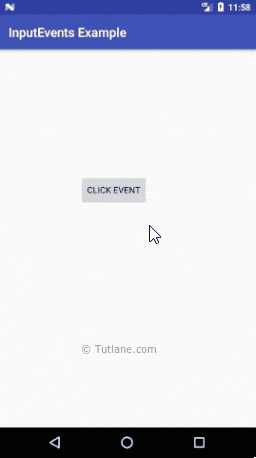In android, Input Events are used to capture the events, such as button clicks, edittext touch, etc. from the View objects that defined in a user interface of our application, when the user interacts with it.
To handle input events in android, the views must have in place an event listener. The View class, from which all UI components are derived contains a wide range event listener interfaces and each listener interface contains an abstract declaration for a callback method. To respond to an event of a particular type, the view must register an appropriate event listener and implement the corresponding callback method.
For example, if a button is to respond to a click event it must register to View.onClickListener event listener and implement the corresponding onClick() callback method. In application when a button click event is detected, the Android framework will call the onClick() method of that particular view.
Generally, to handle input events we use Event Listeners and Event Handling in android applications to listen for user interactions and to extend a View class, in order to build a custom component.
In android, Event Listener is an interface in the View class that contains a single call-back method. These methods will be called by the Android framework when the View which is registered with the listener is triggered by user interaction with the item in UI.
The following are the call-back methods included in the event listener interface.
| Method | Description |
|---|---|
| onClick() | This method is called when the user touches or focuses on the item using navigation-keys or trackball or presses on the "enter" key or presses down on the trackball. |
| onLongClick() | This method is called when the user touches and holds the item or focuses on the item using navigation-keys or trackball and presses and holds "enter" key or presses and holds down on the trackball (for one second). |
| onFocusChange() | This method is called when the user navigates onto or away from the item, using the navigation-keys or trackball. |
| onKey() | This method is called when the user is focused on the item and presses or releases a hardware key on the device. |
| onTouch() | This method is called when the user performs a touch event, including a press, a release, or any movement gesture on the screen. |
| onCreateContextMenu() | This method is called when a Context Menu is being built. |
There are many more event listeners available as a part of View class to use it in our android applications.
In android, Event Registration is the process by which an Event Handler gets registered with an Event Listener so that the handler is called when the Event Listener fires the event.
Following are the different ways to register event listeners in our android applications.
Following is the example of registering a Button onClick event listener in android application.
@Override
protected void onCreate(Bundle savedInstanceState) {
….
// Capture button from our layout
Button button = (Button)findViewById(R.id.btnShow);
// Register onClick listener with the below implementation
button.setOnClickListener(btnListener);
….
}
// Anonymous implementation of OnClickListener
private View.OnClickListener btnListener = new View.OnClickListener() {
public void onClick(View v) {
// do something when the button is clicked
}
};
This is how we can register our event listeners in different ways based on our requirements.
In android, Event Handlers are useful to define several callback methods when we are building custom components from view.
Following are the some of commonly used callback methods for event handling in android applications.
| Method | Description |
|---|---|
| onKeyDown() | This method is called when a new key event occurs. |
| onKeyUp() | This method is called when a key up event occurs. |
| onTrackballEvent() | This method is called when a trackball motion event occurs. |
| onTouchEvent() | This method is called when a touch screen motion event occurs. |
| onFocusChanged() | This method is called when the view gains or loses focus. |
Now we will see how to define input Events using Even Listeners and Event Handling with examples in android applications.
Following is the example of defining an input controls Button, TextView in user interface and showing the text in TextView when users click on Button in the android application.
Create a new android application using android studio and give names as InputEventsExample. In case if you are not aware of creating an app in android studio check this article Android Hello World App.
Now open an activity_main.xml file from \res\layout path and write the code like as shown below
If you observe above code we created a one Button and TextView control in XML Layout file to show the text in textview when we click on Button.
Once we are done with the creation of layout with required controls, we need to load the XML layout resource from our activity onCreate() callback method, for that open main activity file MainActivity.java from \java\com.tutlane.inputeventsexample path and write the code like as shown below.
package com.tutlane.inputeventsexample;
import android.support.v7.app.AppCompatActivity;
import android.os.Bundle;
import android.view.View;
import android.widget.Button;
import android.widget.TextView;
public class MainActivity extends AppCompatActivity {
Button btn;
TextView tView;
@Override
protected void onCreate(Bundle savedInstanceState) {
super.onCreate(savedInstanceState);
setContentView(R.layout.activity_main);
btn = (Button)findViewById(R.id.btnClick);
tView = (TextView)findViewById(R.id.txtResult);
btn.setOnClickListener(new View.OnClickListener() {
@Override
public void onClick(View v) {
tView.setText("You Clicked On Button");
}
});
}
}
If you observe above code we registered our Button click event using setOnClickListener event listener and binding a data to TextView control when we click on button.
Generally, during the launch of our activity, onCreate() callback method will be called by android framework to get the required layout for an activity.
When we run above example using android virtual device (AVD) we will get a result like as shown below

If you observe above result, we are getting binding a text to textview control on button click. This is how we can handle input events in android applications based on our requirements.